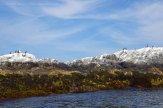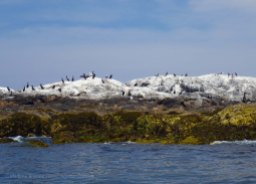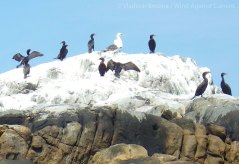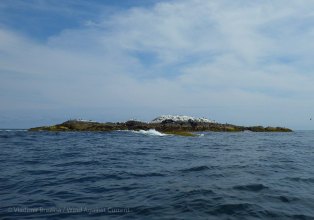By Vladimir Brezina
… the ragged rock in the restless waters,
Waves wash over it, fogs conceal it;
On a halcyon day it is merely a monument,
In navigable weather it is always a seamark
To lay a course by: but in the sombre season
Or the sudden fury, is what it always was.
T.S. Eliot, The Dry Salvages
The Dry Salvages is the third of T.S. Eliot‘s Four Quartets, a landmark of 20th-century English poetry. In a prefatory note, Eliot tells us that the Dry Salvages are a group of isolated rocks offshore in the Atlantic Ocean, but in the body of the poem they are never mentioned again by name. Rather, their symbolic reach expands immediately to encompass one of the larger themes of the poem, that of water as the eternal agent of birth and death. It might seem, therefore, that the Dry Salvages are a mythical place.
But they are real, and a couple of days ago we paddled out to see them.

 The Dry Salvages are located in the Atlantic Ocean about two miles north-east of Rockport, on Cape Ann, Massachusetts. They are “dry” even at high tide, in contrast to an adjacent, lower reef, the Little Salvages, which are submerged at high tide.
The Dry Salvages are located in the Atlantic Ocean about two miles north-east of Rockport, on Cape Ann, Massachusetts. They are “dry” even at high tide, in contrast to an adjacent, lower reef, the Little Salvages, which are submerged at high tide.
Even from the far distance, it was hard to miss the peculiar white peaks rising out of the ocean ahead of us. It almost seemed that we were somewhere in Patagonia, paddling toward a huge snow-covered mountain fifty miles off.
But even when we did reach them, the rocks remained imposing. At low water on a spring tide (as it then was), they towered over us, capped with dazzling white bird guano and surmounted by innumerable birds.
The birds were mostly gulls and many, many cormorants. But at the very top of the rock there stood a beautiful solitary bird, white tinged with yellow, with a gray beak and legs and black-tipped wings, that we later identified (we think) as a Northern Gannet.
Surf beat on the outlying rocks. And the rocks were just the right distance apart, with “interesting” water between them, for some fun rock gardening…

Seals lounged on the rocks, frolicked in the water, and swam up almost to touch our boats.


As might be expected with such dangerous rocks, around them are several wrecks. We came across one that was only partly submerged at low tide.
The blue sea and sky, surf-beaten offshore rocks, wrecks, birds, seals… Clearly, T.S. Eliot knew what he was about. Quite apart from their literary connotations, the Dry Salvages are a kayaker’s paradise!
(click on any photo to start slideshow)
.
And this was just one stop on our trip around Cape Ann—more to come!





























This might be your best post in my reading, Vlad. Mysterious with bird guano and T.S. Elliot no less. I’ll go back to The Four Quartets soon.
LikeLike
Johna seems to agree with you :-) Thanks, Frank!!
LikeLike
AH born and raised in Mass and adore the sea but never will you see me paddle out there :)
I loved your post as it is apart of who I am a Sea Lover oh bird lover too
LikeLike
That’s definitely a place for birds! I think many of these outlying, uninhabited islands are. The birds congregate there by the thousands. it’s their domain and they are not shy at all…
LikeLike
I found a sad foot long bird ,up in the sand along the beach in Salisbury MA during winter white belly and struggling to get up or away from me and the dog looked as if it may have had film over it’s eyes :( so sad some I showed the photo too thought it maybe one of those birds,
LikeLike
Sad… you mean a gannet, rather than a gull? Could well be. Apparently gannets are fairly common along the East Coast, especially as one goes north, but I can’t say I ever noticed one before the one on this trip.
LikeLike
Either that or a Conant(sp) I felt so bad I knew it could not be hatching in those temps but it was so helpless and the dog with me I hated walking away I fear it will always haunt me not knowing what to do. :(
LikeLike
Not much you can do under those circumstances. My mother took home two or three birds that she found like that on the beach that were obviously injured, but they all died…
LikeLike
Thanks Comeraunt(SP) someone though who saw the photo but Odd looking I wanted to pick it up like your Mom and bring it to get help but did not want the dog to get hurt if it lashed out in pain or being scared I was unsure it was even a bird just so odd I do not think I can add photos to this conversation
LikeLike
Actually you can add a link to the photo if you want.
LikeLike
Really OK I will try maybe you will know exactly what it was.
LikeLike
I sent it by email thanks for checking it out
LikeLike
Here is nutsfortreasure’s photo of a sick bird she found at the beach:
I can’t tell what kind of bird it is from the photo. If anyone has an idea, please advise, and what to do if one finds a bird like that…
LikeLike
Thanks so much for that Vladimir.
LikeLike
Bluebrightly has provided some relevant information in a comment below—take a look :-)
LikeLike
Thanks!
LikeLike
This is just incredible! I live in Massachusetts and have never heard of The Dry Salvages. Heading off to read some T.S. Elliot…thank you for sharing this and I look forward to seeing more of Cape Ann through your lens!
LikeLike
If it sends you off to read some T.S. Eliot, it’s all good! :-)
More Cape Ann coming up soon!
LikeLike
That is a serious amount of bird poop. I thought it was snow at first! Nice post.
LikeLike
Guano here is just a thin coating of the rocks. Nothing compared to some other places, where the guano makes up the rocks. From Wikipedia:
“During the guano boom of the nineteenth century, the vast majority of seabird guano was harvested from Peruvian guano islands, but large quantities were also exported from the Caribbean, atolls in the Central Pacific, and islands off the coast of Namibia, Oman, Patagonia, and Baja California. At that time, massive deposits of guano existed on some islands, in some cases more than 50 m deep. In this context the United States passed the Guano Islands Act in 1856, which gave U.S. citizens discovering a source of guano on an unclaimed island exclusive rights to the deposits. Nine of these islands are still officially U.S. territories. Control over guano played a central role in the Chincha Islands War (1864–1866) between Spain and a Peruvian-Chilean alliance. Indentured workers from China played an important role in guano harvest…”
Guano was clearly an important geopolitical strategic commodity at one time… :-)
LikeLike
whoa … that’s alotta lotta guano!
LikeLike
Yes—the amount on the Dry Salvages is just a drop in comparison :-)
LikeLike
That’s Grey whale territory , did ya spy any ?
LikeLike
We were hoping! But no.
But I gather that Gloucester is a big whale-watching port these days (friends who were there at the same time went whale-watching the previous day) with almost guaranteed sightings… don’t know if of Greys though…
LikeLike
Really cool shots! Fabulous trip around Cape Ann.
LikeLike
Thanks, Amy! The rest of the trip is yet to come…
LikeLike
What a great adventure out to see the Dry Salvages.
LikeLike
It was indeed! Thanks, Mary! :-)
LikeLike
What a great post with photos so special ! :)
LikeLike
Thanks so much, Karen! :-)
LikeLike
Wonderful post on all fronts.
LikeLike
Thank you, Tish!
LikeLike
yes, wonderful information and photos and fun!
LikeLike
Glad you liked it! :-)
LikeLike
Very cool about the Dry Salvages! I enjoyed all the photos
LikeLike
Thanks!!
LikeLike
This post reveals a deft transformation from kayaker to littérateur.
LikeLike
:-) Actually more the other way round…
LikeLike
Who’d have guessed? But then I took a similar turn from language, too; what changelings we are.
LikeLike
Not a complete turn from language, clearly. Your language still comes through on your blog—one of its attractions!
LikeLike
Beautiful photos! I, too, have lived in MA my whole life and never heard of the Dry Salvages. My first thought was “where there are seals…there are are sharks.” But maybe that’s only a bit farther south near Cape Cod.
LikeLike
On Cape Cod, where there are concentrations of seals, sharks have been sighted repeatedly in recently years. Elsewhere—there’s always a possibility, but what can you do? There are seals on every outlying rock, probably, from Massachusetts up to Canada. Hopefully the sharks have to divide their attention ;-)
LikeLike
Steve Schwartzman sent on this post of yours, and I’m so glad he did! Poetry and nature, who can beat that?
LikeLike
And may I add: this kind of wonderful post is exactly what’s making it so hard for me to step away from the internet for a while, as I must so as to be a good hostess to arriving guests. But so glad to have found you: I’ve got you in my reader and look forward to coming by again!
LikeLike
Thanks for visiting (and signing up to follow our blog), Susan, and thank you, Steve! I can see why Steve sent you to this post—it’s very much in the spirit of the posts on your own lovely blog, to which we’ll have to return for a more careful reading! :-)
LikeLike
That does look like a Gannet. Great photos!
LikeLike
Thanks! Unfortunately I couldn’t get close enough to the gannet to take a good photo of it, given the camera I had…
LikeLike
Great post! And yes, it looks like a Gannet. The sick bird may have been a grebe – there are several species. It sounds and looks like it was too far gone to help. Sometimes, when a bird (not a seabird) is stunned (e.g. by flying into a window) or temporarily sick, if it’s easy to catch, you can help by gently closing your hands around it & putting it in a quiet, dark place – like cardboard box with a towel in it. You can try droppers of water if it perks up, and release it in a safe area as soon as it looks able to fly again. I’ve had that experience with several birds over the years. But not sea birds! And of course many areas have wild animal rescue groups that can be called for advice.
LikeLike
Thanks for that information—I’ll point it out to nutsfortreasure…
LikeLike
This is great post, with stunning photos, and rich of information.
Thank you for sharing.
LikeLike
Thanks—you are most welcome!!
LikeLike
Thanks so much for the information I may contact the group for the Sea Birds and be ready the next time I hated walking away.
When you walk the beaches in 35 mph winter winds you have the place to yourself and come upon amazing things but this one was bad just sick over not knowing what to do I will have their number with me from this point on again thanks to both of you.
Eunice
LikeLike
Glad to have been useful, to the extent I was…
LikeLike
:)
LikeLike
So cool!!!!!
LikeLike
:-) Thank you!
LikeLike
Pingback: Weekly Photo Challenge: On Top, Take Two | Wind Against Current
great pictures, thanks for showing me where there were; seals have happy faces :)
LikeLike
:-) You are welcome!
LikeLike
Pingback: The Day's Catch - The Wine-Dark Sea